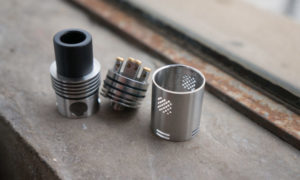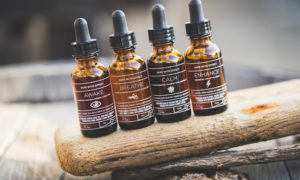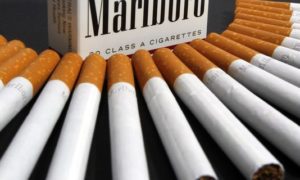In the most comprehensive chemical comparison to date between smoke and e-cigarette emissions, scientists at British American Tobacco ("BAT") have found evidence that e-cigarette vapour* has significantly lower levels of toxicants than conventional cigarette smoke.
Analysis of vapour emitted by the Vype ePen - a commercially available e-cigarette manufactured by Nicoventures, a company owned by BAT, - revealed that toxicant levels in e-pen vapour were 92 to 99% lower (depending on which regulatory list of toxicants is used) than in cigarette smoke. The findings were published today in Chemical Research in Toxicology, a peer-reviewed publication by the American Chemical Society.
While not representative of all vaping products, the findings reinforce a growing body of research establishing the potential for e-cigarettes to reduce the public heath impact of smoking.
The research is the first in a series of scientific papers from BAT on the risk assessment of e-cigarette vapour to be published in the coming months and throughout 2017.
Dr Kevin McAdam, Head of Next Generation Product Risk Assessment at British American Tobacco said:
"For us, it's essential that our consumers know the products they are using are of the highest quality. As a result, we believe it is important to look at and evaluate the components of the vapour that is emitted and this is a vital first step to understanding the true risk reduction potential of e-cigarettes.
"Despite millions of people using e-cigarettes (the current estimate in Great Britain is 2.8 million), very little research exists on the chemical make-up of the vapour. BAT is committed to setting the bar on standards for product safety and quality based on robust scientific assessments. That's why we have invested more than £500 million in researching and developing a range of products for consumers looking for less risky alternatives to cigarettes."
Many in the public health community believe e-cigarettes offer great potential for reducing the public health impact of smoking. Public Health England, an executive body of the UK Department of Health, recently published a report saying that e-cigarettes are 95% less harmful than cigarettes. Similarly, The Royal College of Physicians has said that the public can be reassured that e-cigarettes are likely to be much safer then smoking and that they should be widely promoted as an alternative to cigarettes, though called for additional research. Cancer Research UK, Action on Smoking and Health, and the British Heart Foundation are also of the view that e-cigarettes are substantially less harmful than smoking.
BAT plans to follow this chemistry assessment with a series of tests examining the biological impact of vapour on human cells, due to be peer-reviewed and published over the coming year.
Notes to Editors:
*Vapour refers to the makeup of the aerosol produced by an e-cigarette. In this instance it has been compared to cigarette smoke. The results demonstrate the much simpler composition of Vype e-pen e-cigarette vapour in comparison to smoke.
Research findings and Methodology
- British American Tobacco tested for a total of 142 compounds, including those listed by the US Food and Drug Administration (FDA) as harmful or potentially harmful (HPHC), and by the World Health Organisation (WHO) and Health Canada.
- The products tested were Vype ePen Blended Tobacco flavour and the Kentucky Reference Cigarette 3R4F. The products were puffed using puffing robots in separate rooms and the emissions collected. Because the levels of some constituents in e-cigarette vapour were anticipated to be very low, the air was also tested to eliminate the possibility of contamination and false positives.
- Independent contract labs were commissioned to quantify the following emissions: carbon/nitrogen oxides, carbonyls/dicarbonyls, alcohols/di-alcohols, phenols, o-heterocycles, chlorinated dioxins/furans; volatile, substituted and, polynuclear aromatic hydrocarbons; amides, azines, aromatic and aliphatic amines, nicotine & related compounds, nitrosamines, metals and radionuclides (shown below).
- Comparison of toxicant emissions between Vype ePen and 3R4F were conducted on a per-puff basis. The results revealed a reduction of 99% for WHO and FDA truncated lists, and over 92% for the full FDA HPHC list.
- Three aerosol constituents were measured at higher per-puff levels in e-cigarette vapour than from 3R4F - propylene glycol (PG), vegetable glycerine (VG) and menthol. PG and VG are used to make e-liquid and menthol is used as a flavour.
About British American Tobacco: British American Tobacco is the world's second largest public tobacco group by global market share, with brands sold in over 180 markets and employing over 50,000 people.
About Next Generation Products (NGP): The NGP division of British American Tobacco is focused on increasing consumer choice through developing a range of less risky nicotine and tobacco products for adult smokers including Tobacco Heating Products, Vapour products and Licensed Medicines. For more information see http://www.goVype.com and http://www.bat-science.com.
About Tobacco Harm Reduction: The only way to avoid the risks associated with tobacco use is not to consume tobacco at all, and the best way to reduce the risks is to stop using tobacco. However, the concept of harm reduction is increasingly being considered in relation to tobacco use. Harm reduction is about finding practical ways to minimise the health impact of an inherently risky activity or behaviour, without seeking to stop it entirely. It is a key element of BAT's business strategy and is being discussed by some regulators. An example of harm reduction in action is the use of seat belts and airbags in cars. We think it's important to work towards producing consumer-acceptable, potentially reduced risk products. We believe that tobacco regulatory policies should include harm reduction approaches for the millions of adults globally who will continue to consume tobacco products.
SOURCE BAT (British American Tobacco)
Click here to view original web page at www.prnewswire.co.uk






















